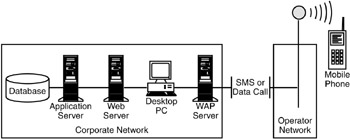22.4 Operating Systems for WAP
22.4 Operating Systems for WAP
WAP is a communications protocol and an application environment. It can be built on any operating system including PalmOS , EPOC, Windows CE, FLEXOS, OS/9, and JavaOS. WAP provides service interoperability even between different device families. WAP uses existing Internet standards, and the WAP architecture (illustrated in Figure 22.1) was designed to enable standard off-the-shelf Internet servers to provide services to wireless devices.

Figure 22.1: WAP architecture.
In addition to wireless devices, WAP uses many Internet additions when communicating standards such as XML, UDP, and IP. WAP wireless protocols are based on Internet standards such as HTTP and Transport Layer Security (TLS), but have been optimized for the unique constraints of the wireless environment. Internet standards such as HTML, HTTP, TLS, and TCP are inefficient over mobile networks, requiring large amounts of mainly text-based data to be sent. Standard HTML Web content generally cannot be displayed in an effective way on the small screens of pocket-sized mobile telephones and pagers, and navigation around and between screens is not easy in one-handed mode. HTTP and TCP are not optimized for the intermittent coverage, long latencies, and limited bandwidth associated with wireless networks. HTTP sends its headers and commands in an inefficient text format instead of compressed binary. Wireless services using these protocols are often slow, costly, and difficult to use. The TLS security standard requires many messages to be exchanged between client and server which, with wireless transmission latencies, results in a very slow response for the user. WAP has been optimized to solve all these problems, utilizing binary transmission for greater compression of data, and is optimized for long latency and low-to-medium bandwidth. WAP sessions cope with intermittent coverage and can operate over a wide variety of wireless transports using IP where it is possible and other optimized protocols where IP is impossible. The WML used for WAP content makes optimum use of small screens; allows easy, one-handed navigation without a full keyboard; and has built-in scalability from two-line text displays through to the full graphic screens on smart telephones and communicators. [6] Figure 22.2 illustrates the relationship between WAP and the Web.

Figure 22.2: WAP and the Web.
[6]Johnson, A.H., WAP, Computerworld, November 1, 1999, pp. 33–44.
EAN: 2147483647
Pages: 239